Pesticide Residues in Fruits and Vegetables from Cape Verde: A Multi-Year Monitoring and Dietary Risk Assessment Study
Abstract
1. Introduction
2. Materials and Methods
2.1. Study Area and Sample Selection
2.2. Sample Preparation and Residue Extraction
2.3. Multi-Residue Analysis by Chromatography
2.4. Estimation of Dietary Exposure and Risk Assessment
2.5. Statistical Analysis
3. Results
3.1. Occurrence of Pesticide Residues in Fruits and Vegetables in Cape Verdean Markets
3.2. Dietary Exposure to Pesticide Residues in the Cape Verdean Population
3.3. Risk Characterization of Dietary Exposure to Pesticide Residues
4. Discussion
4.1. Prevalence and Patterns of Pesticide Contamination in Fruits and Vegetables of the Cape Verdean Market
4.2. Dietary Exposure and Risk Characterization
5. Conclusions
Supplementary Materials
Author Contributions
Funding
Institutional Review Board Statement
Informed Consent Statement
Data Availability Statement
Conflicts of Interest
References
- Carrasco Cabrera, L.; Medina Pastor, P. The 2019 European Union Report on Pesticide Residues in Food. EFSA J. 2021, 19, e06491. [Google Scholar] [CrossRef] [PubMed]
- Shattuck, A.; Werner, M.; Mempel, F.; Dunivin, Z.; Galt, R. Global Pesticide Use and Trade Database (GloPUT): New Estimates Show Pesticide Use Trends in Low-Income Countries Substantially Underestimated. Glob. Environ. Chang. 2023, 81, 102693. [Google Scholar] [CrossRef]
- Crépet, A.; Luong, T.M.; Baines, J.; Boon, P.E.; Ennis, J.; Kennedy, M.; Massarelli, I.; Miller, D.; Nako, S.; Reuss, R.; et al. An International Probabilistic Risk Assessment of Acute Dietary Exposure to Pesticide Residues in Relation to Codex Maximum Residue Limits for Pesticides in Food. Food Control 2021, 121, 107563. [Google Scholar] [CrossRef]
- Poulsen, M.E.; Andersen, J.H.; Petersen, A.; Jensen, B.H. Results from the Danish Monitoring Programme for Pesticide Residues from the Period 2004–2011. Food Control 2017, 74, 25–33. [Google Scholar] [CrossRef]
- Mutengwe, M.T.; Chidamba, L.; Korsten, L. Monitoring Pesticide Residues in Fruits and Vegetables at Two of the Biggest Fresh Produce Markets in Africa. J. Food Prot. 2016, 79, 1938–1945. [Google Scholar] [CrossRef] [PubMed]
- Donkor, A.; Osei-Fosu, P.; Dubey, B.; Kingsford-Adaboh, R.; Ziwu, C.; Asante, I. Pesticide Residues in Fruits and Vegetables in Ghana: A Review. Environ. Sci. Pollut. Res. 2016, 23, 18966–18987. [Google Scholar] [CrossRef] [PubMed]
- Bertrand, P.G.; Bertrand, P.G. Uses and Misuses of Agricultural Pesticides in Africa: Neglected Public Health Threats for Workers and Population. In Pesticides—Use and Misuse and Their Impact in the Environment; IntechOpen: London, UK, 2019. [Google Scholar] [CrossRef]
- Taiwo, A.M. A Review of Environmental and Health Effects of Organochlorine Pesticide Residues in Africa. Chemosphere 2019, 220, 1126–1140. [Google Scholar] [CrossRef] [PubMed]
- Olisah, C.; Okoh, O.O.; Okoh, A.I. Occurrence of Organochlorine Pesticide Residues in Biological and Environmental Matrices in Africa: A Two-Decade Review. Heliyon 2020, 6, e03518. [Google Scholar] [CrossRef] [PubMed]
- Chen, C.; Qian, Y.; Chen, Q.; Tao, C.; Li, C.; Li, Y. Evaluation of Pesticide Residues in Fruits and Vegetables from Xiamen, China. Food Control 2011, 22, 1114–1120. [Google Scholar] [CrossRef]
- Claeys, W.L.; Schmit, J.F.; Bragard, C.; Maghuin-Rogister, G.; Pussemier, L.; Schiffers, B. Exposure of Several Belgian Consumer Groups to Pesticide Residues through Fresh Fruit and Vegetable Consumption. Food Control 2011, 22, 508–516. [Google Scholar] [CrossRef]
- Henríquez-Hernández, L.A.; Macías-Montes, A.; Acosta-Dacal, A.; Rial-Berriel, C.; Duarte-Lopes, E.; Lopes-Ribeiro, A.L.; Alfama, P.M.; Livramento, M.; Zumbado, M.; Díaz-Díaz, R.; et al. Human Biomonitoring of Persistent and Non-Persistent Pollutants in a Representative Sample of the General Population from Cape Verde: Results from the PERVEMAC-II Study. Environ. Pollut. 2022, 306, 119331. [Google Scholar] [CrossRef] [PubMed]
- Henríquez-Hernández, L.A.; Zumbado, M.; Rodríguez-Hernández, Á.; Duarte-Lopes, E.; Lopes-Ribeiro, A.L.; Alfama, P.M.; Livramento, M.; Díaz-Díaz, R.; Bernal-Suárez, M.d.M.; Boada, L.D.; et al. Human Biomonitoring of Inorganic Elements in a Representative Sample of the General Population from Cape Verde: Results from the PERVEMAC-II Study. Chemosphere 2023, 339, 139594. [Google Scholar] [CrossRef] [PubMed]
- Corral, S.; Díaz, A.S.; Monagas, M.d.C.; García, E.C. Agricultural Policies and Their Impact on Poverty Reduction in Developing Countries: Lessons Learned from Three Water Basins in Cape Verde. Sustainability 2017, 9, 1841. [Google Scholar] [CrossRef]
- Acosta-Dacal, A.; Hernández-Marrero, M.E.; Rial-Berriel, C.; Díaz-Díaz, R.; Bernal-Suárez, M.d.M.; Zumbado, M.; Henríquez-Hernández, L.A.; Boada, L.D.; Luzardo, O.P. Comparative Study of Organic Contaminants in Agricultural Soils at the Archipelagos of the Macaronesia. Environ. Pollut. 2022, 301, 118979. [Google Scholar] [CrossRef] [PubMed]
- Alonso González, P.; Parga-Dans, E.; Pérez Luzardo, O. Big Sales, No Carrots: Assessment of Pesticide Policy in Spain. Crop Prot. 2021, 141, 105428. [Google Scholar] [CrossRef]
- Monteiro, F.; Fortes, A.; Ferreira, V.; Essoh, A.P.; Gomes, I.; Manuel Correia, A.; Romeiras, M.M. Current Status and Trends in Cabo Verde Agriculture. Agronomy 2020, 10, 74. [Google Scholar] [CrossRef]
- Rubio-Armendáriz, C.; Paz, S.; Gutiérrez, Á.J.; Furtado, V.G.; González-Weller, D.; Revert, C.; Hardisson, A. Toxic Metals in Cereals in Cape Verde: Risk Assessment Evaluation. Int. J. Environ. Res. Public Health 2021, 18, 3833. [Google Scholar] [CrossRef] [PubMed]
- WFP; FAO. Hunger Hotspots FAO-WFP Early Warnings on Acute Food Insecurity: February to May 2022 Outlook. 2022. Available online: https://digitallibrary.un.org/record/4058541?v=pdf (accessed on 4 April 2025).
- Brilhante, M.; Varela, E.; Essoh, A.P.; Fortes, A.; Duarte, M.C.; Monteiro, F.; Ferreira, V.; Correia, A.M.; Duarte, M.P.; Romeiras, M.M. Tackling Food Insecurity in Cabo Verde Islands: The Nutritional, Agricultural and Environmental Values of the Legume Species. Foods 2021, 10, 206. [Google Scholar] [CrossRef] [PubMed]
- Keikotlhaile, B.M.; Spanoghe, P. Pesticide Residues in Fruits and Vegetables. In Pesticides—Formulations, Effects, Fate; IntechOpen: London, UK, 2011; Volume 30, pp. 511–512. ISBN 978-953-307-532-7. [Google Scholar]
- Philippe, V.; Neveen, A.; Marwa, A.; Ahmad Basel, A.Y. Occurrence of Pesticide Residues in Fruits and Vegetables for the Eastern Mediterranean Region and Potential Impact on Public Health. Food Control 2021, 119, 107457. [Google Scholar] [CrossRef]
- Rial-Berriel, C.; Acosta-Dacal, A.; Zumbado, M.; Luzardo, O.P. Micro QuEChERS-Based Method for the Simultaneous Biomonitoring in Whole Blood of 360 Toxicologically Relevant Pollutants for Wildlife. Sci. Total Environ. 2020, 736, 139444. [Google Scholar] [CrossRef] [PubMed]
- Masson-Matthee, M.D. The Codex Alimentarius Commission and Its Standards; T.M.C. Asser Press: The Hague, The Netherlands, 2007; ISBN 9789067042567. [Google Scholar]
- Zikankuba, V.L.; Mwanyika, G.; Ntwenya, J.E.; James, A. Pesticide Regulations and Their Malpractice Implications on Food and Environment Safety. Cogent Food Agric. 2019, 5. [Google Scholar] [CrossRef]
- Lopes, D.; Aguiar, A.; Dias, A.; Bettencourt, M.; Fernandes, P.; Pimentel, R. A Importância Do Projeto Pervermac II No Uso Sustentável de Pesticidas Em Fruticultura e Seu Impacto Na Saúde Humana Na Macaronésia. O Caso Dos Açores. Rev. Ciências Agrárias 2018, 41, 156–163. [Google Scholar]
- Rubio-Armendáriz, C.; Gutiérrez, Á.J.; Gomes-Furtado, V.; González-Weller, D.; Revert, C.; Hardisson, A.; Paz, S. Essential Metals and Trace Elements in Cereals and Their Derivatives Commercialized and Consumed in Cape Verde. Biol. Trace Elem. Res. 2023, 201, 444–454. [Google Scholar] [CrossRef] [PubMed]
- Proyecto Pervemac2. Available online: https://www.pervemac2.com/ (accessed on 6 July 2025).
- Pervemac Estudio de La Salubridad Alimentaria de Los Productos Vegetales. Available online: https://pervemac.itccanarias.org/ (accessed on 6 July 2025).
- UNE-EN ISO/IEC 17025:2017; Asociación Española de Normalización (UNE): Madrid, Spain, 2017; (accessed on 25 March 2025).
- SANTE/12682/2019; Analytical Quality Control and Method Validation for Pesticide Residues Analysis in Food and Feed. European Commission: Brussels, Belgium, 2019.
- SANTE/12682; Guidance Document on Analytical Quality Control and Validation Procedures for Pesticide Residues Analysis in Food and Feed. European Commission, Health & Consumer Protection Directorate-General: Brussels, Belgium, 2019.
- Lubin, J.H.; Colt, J.S.; Camann, D.; Davis, S.; Cerhan, J.R.; Severson, R.K.; Bernstein, L.; Hartge, P. Epidemiologic Evaluation of Measurement Data in the Presence of Detection Limits. Environ. Health Perspect. 2004, 112, 1691–1696. [Google Scholar] [CrossRef] [PubMed]
- Harter, T. Nondetects and Data Analysis: Statistics for Censored Environmental Data. Vadose Zone J. 2006, 5, 508–509. [Google Scholar] [CrossRef]
- EC. EU Pesticides Database. Available online: https://food.ec.europa.eu/plants/pesticides/eu-pesticides-database_en (accessed on 9 March 2025).
- Pouokam, G.B.; Album, W.L.; Ndikontar, A.S.; Sidatt, M.E.H. A Pilot Study in Cameroon to Understand Safe Uses of Pesticides in Agriculture, Risk Factors for Farmers’ Exposure and Management of Accidental Cases. Toxics 2017, 5, 30. [Google Scholar] [CrossRef] [PubMed]
- Crépet, A.; Vanacker, M.; Sprong, C.; de Boer, W.; Blaznik, U.; Kennedy, M.; Anagnostopoulos, C.; Christodoulou, D.L.; Ruprich, J.; Rehurkova, I.; et al. Selecting Mixtures on the Basis of Dietary Exposure and Hazard Data: Application to Pesticide Exposure in the European Population in Relation to Steatosis. Int. J. Hyg. Environ. Health 2019, 222, 291–306. [Google Scholar] [CrossRef] [PubMed]
- EFSA. Results of the Monitoring of Non Dioxin-like PCBs in Food and Feed. EFSA J. 2010, 8, 1701–1736. [Google Scholar] [CrossRef]
- Lu, C.; Barr, D.B.; Pearson, M.A.; Waller, L.A. Dietary Intake and Its Contribution to Longitudinal Organophosphorus Pesticide Exposure in Urban/Suburban Children. Environ. Health Perspect. 2008, 116, 537–542. [Google Scholar] [CrossRef] [PubMed]
- Winter, C.K. Chronic Dietary Exposure to Pesticide Residues in the United States. Int. J. Food Contam. 2015, 2, 11. [Google Scholar] [CrossRef]
- Hernández, A.F.; Gil, F.; Lacasaña, M. Toxicological Interactions of Pesticide Mixtures: An Update. Arch. Toxicol. 2017, 91, 3211–3223. [Google Scholar] [CrossRef] [PubMed]
- Hernández, A.F.; Parrón, T.; Tsatsakis, A.M.; Requena, M.; Alarcón, R.; López-Guarnido, O. Toxic Effects of Pesticide Mixtures at a Molecular Level: Their Relevance to Human Health. Toxicology 2013, 307, 136–145. [Google Scholar] [CrossRef] [PubMed]
- EFSA Panel on Plant Protection Products and their Residues (PPR). Scientific Opinion on the Identification of Pesticides to Be Included in Cumulative Assessment Groups on the Basis of Their Toxicological Profile. EFSA J. 2013, 11, 3293. [Google Scholar] [CrossRef]
- Crivellente, F.; Hart, A.; Hernandez-Jerez, A.F.; Hougaard Bennekou, S.; Pedersen, R.; Terron, A.; Wolterink, G.; Mohimont, L. Establishment of Cumulative Assessment Groups of Pesticides for Their Effects on the Nervous System. EFSA J. 2019, 17, e05800. [Google Scholar] [CrossRef] [PubMed]
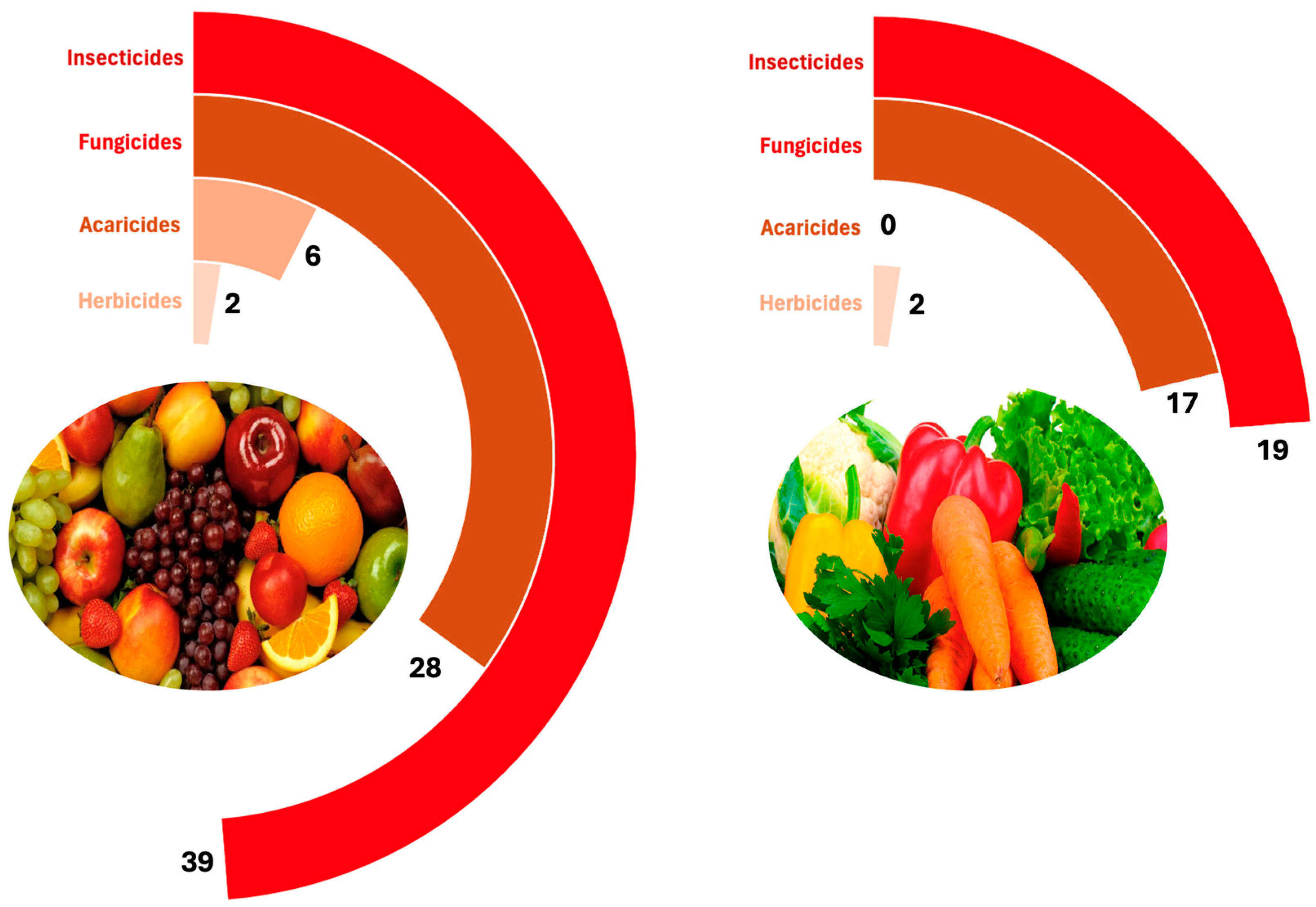
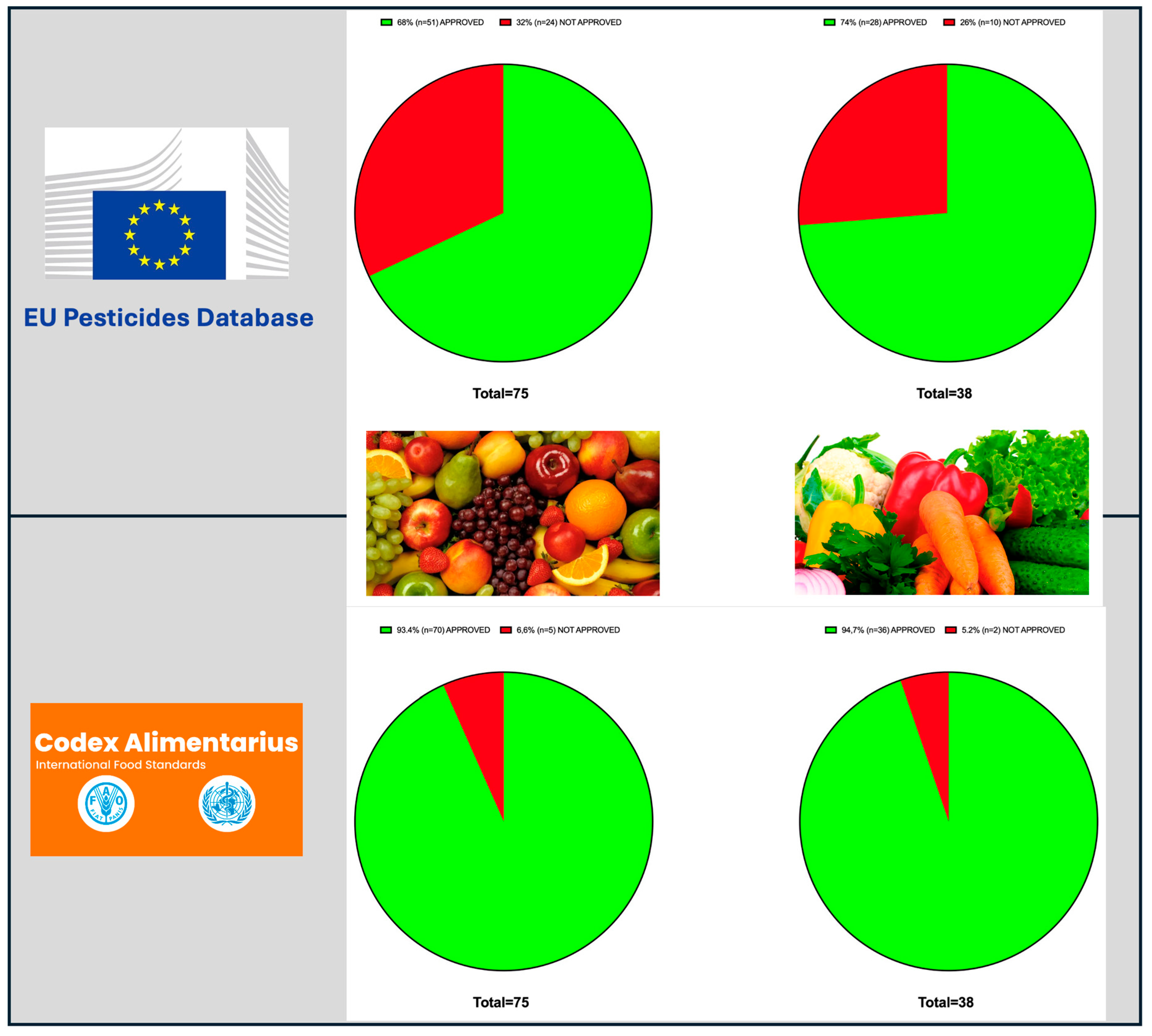
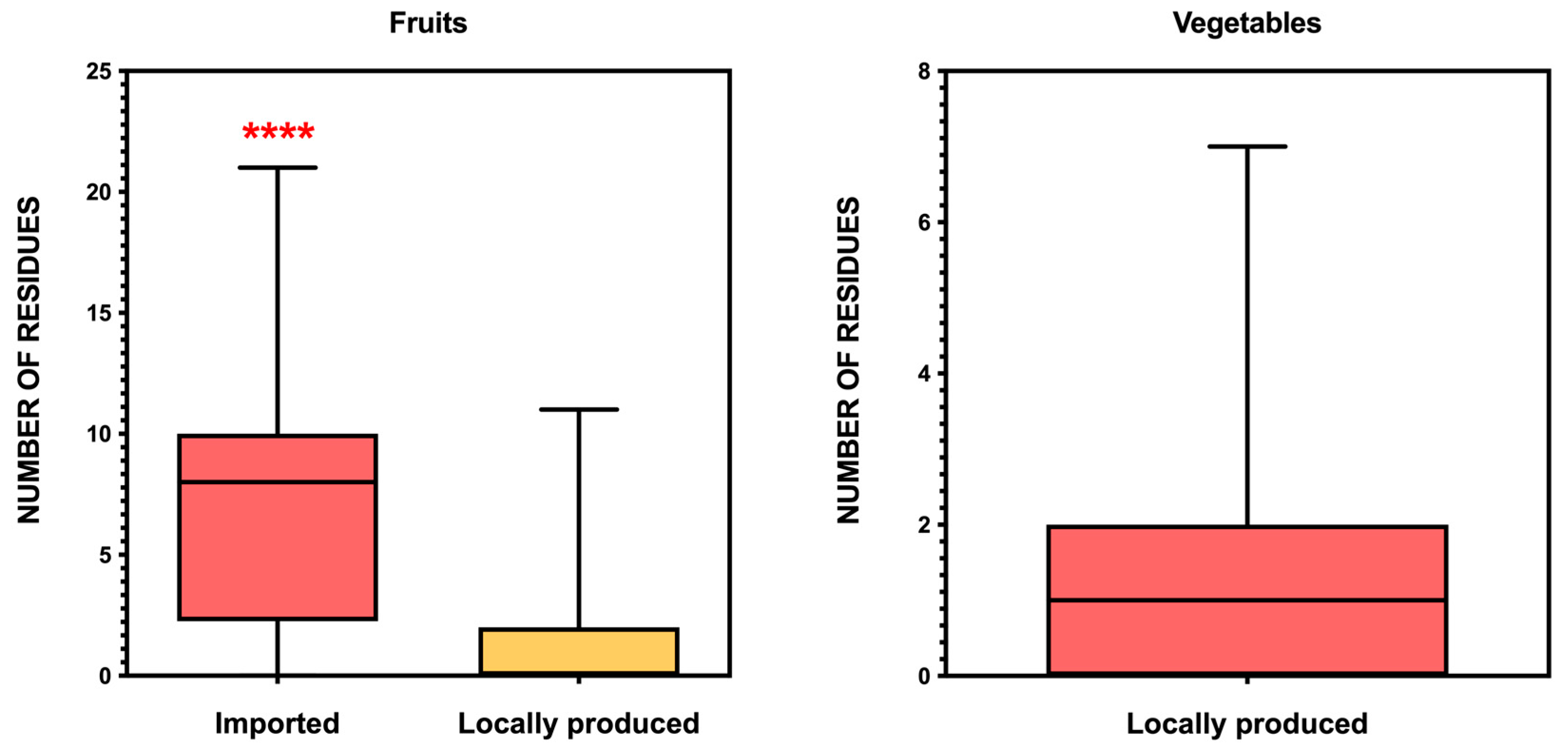
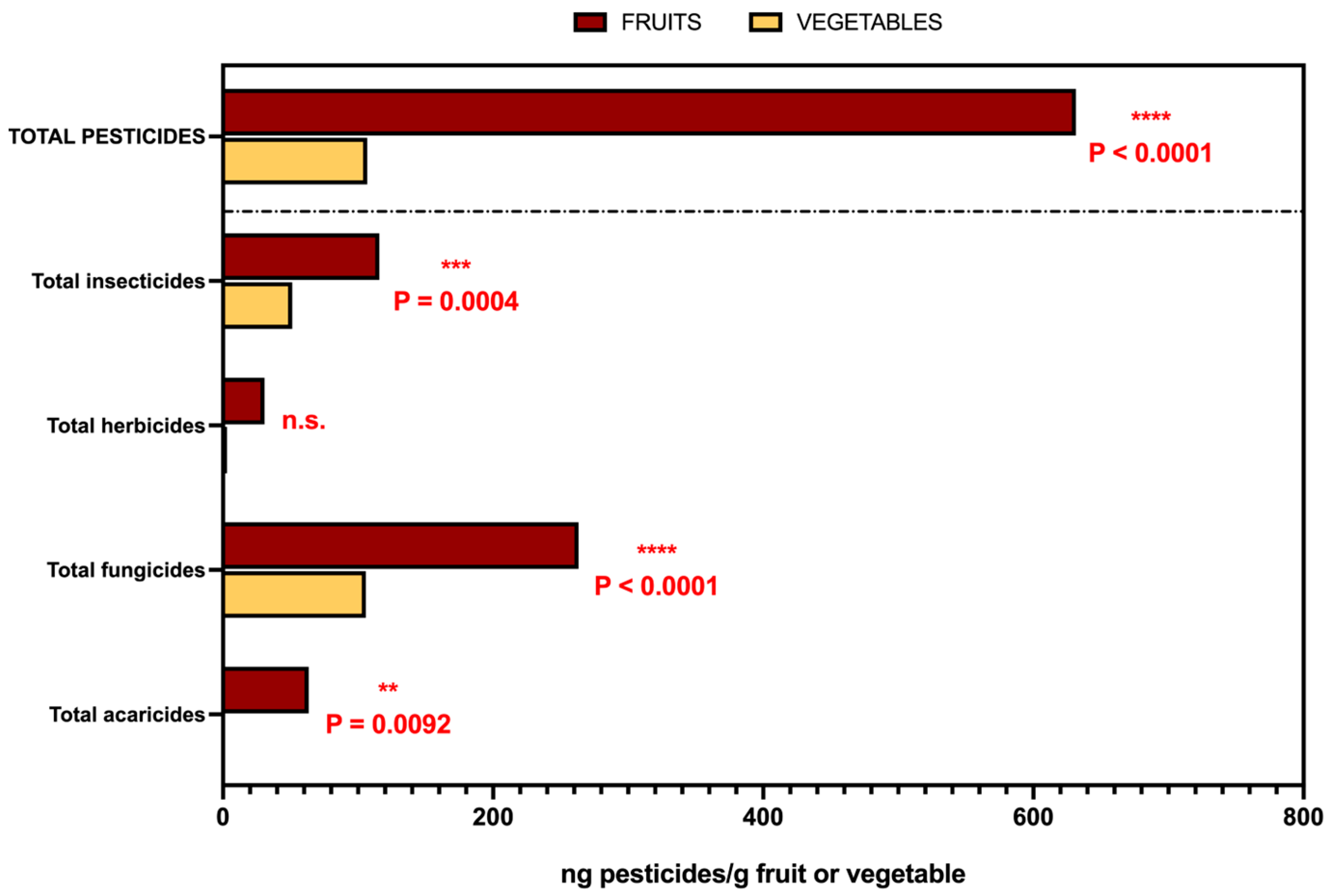
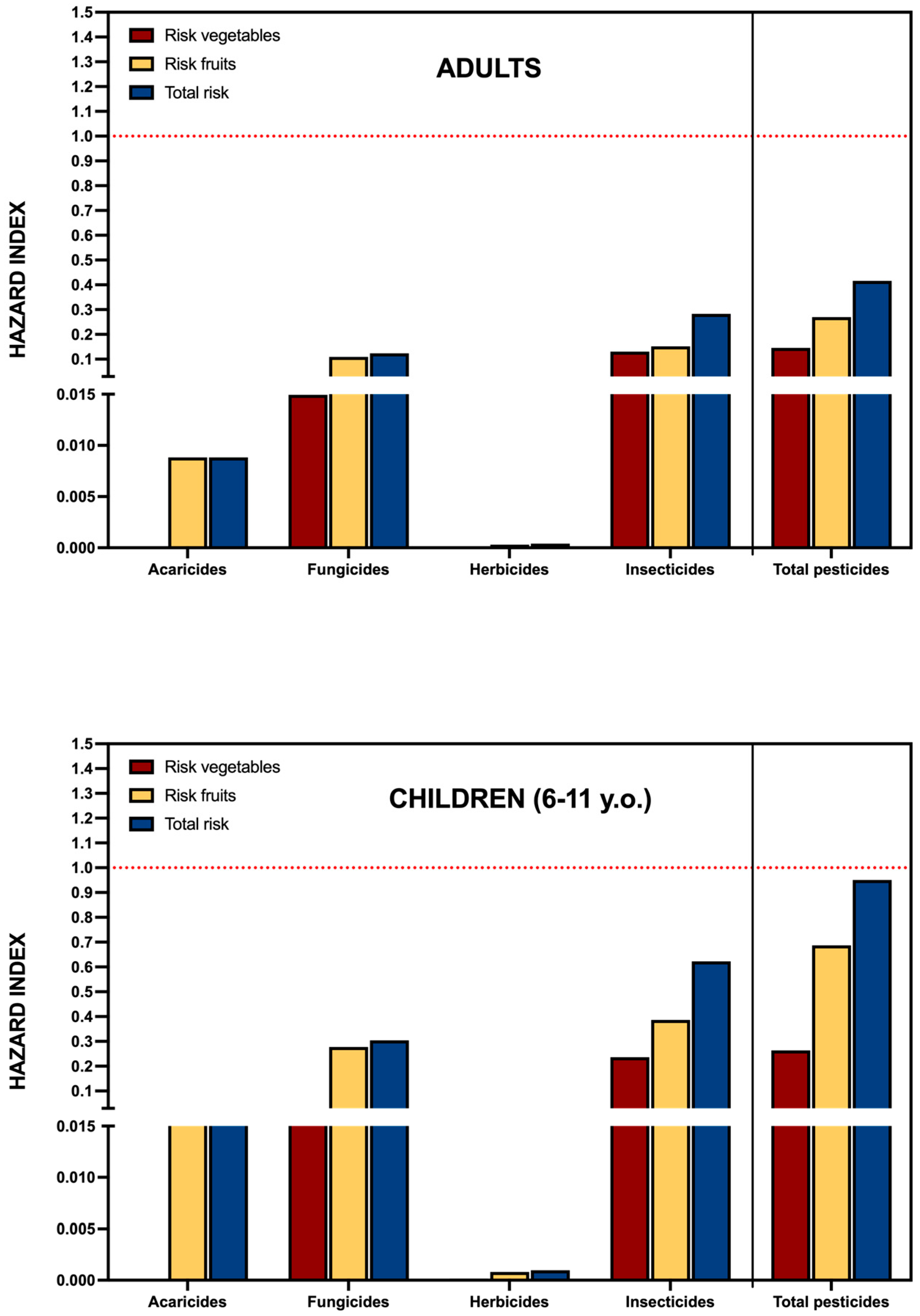
| Fruits * | ||||||||||||||||||||||
|---|---|---|---|---|---|---|---|---|---|---|---|---|---|---|---|---|---|---|---|---|---|---|
| Apple (n = 22) | Banana (n = 16) | Clementine (n = 15) | Grape (n = 27) | Kiwi (n = 4) | Lemon (n = 7) | Orange (n = 21) | Papaya (n = 20) | Pear (n = 21) | Prune (n = 4) | Watermelon (n = 17) | ||||||||||||
| Pesticide | N | Median | N | Median | N | Median | N | Median | N | Median | N | Median | N | Median | N | Median | N | Median | N | Median | N | Median |
| Etoxazole | 1 | 3.4 | 2 | 11.6 | 1 | 10.0 | ||||||||||||||||
| Hexythiazox | 1 | 5.6 | ||||||||||||||||||||
| Spirodiclofen | 5 | 20.0 | 2 | 11.2 | 1 | 7.0 | ||||||||||||||||
| Tebufenpyrad | 3 | 10.0 | 1 | 10.0 | ||||||||||||||||||
| Tetradifon | 1 | 10.0 | ||||||||||||||||||||
| Total acaricides | 8 | 25.0 | 8 | 371.6 | 1 | 30.0 | 10 | 28.5 | 1 | 1.7 | ||||||||||||
| Azoxystrobin | 2 | 530.0 | 1 | 60.0 | 1 | 8.6 | 1 | 10.0 | ||||||||||||||
| Boscalid | 13 | 6.7 | 1 | 110.0 | 1 | 2.3 | 3 | 320.0 | 11 | 40.0 | 1 | 3.8 | 1 | 2.6 | ||||||||
| Carbendazim | 2 | 5.6 | 1 | 7.3 | ||||||||||||||||||
| Cyprodinil | 1 | 5.2 | 1 | 2.4 | 2 | 254.1 | 1 | 6.1 | ||||||||||||||
| Difenoconazole | 13 | 4.8 | 1 | 10.0 | 1 | 2.0 | 1 | 3.1 | 9 | 5.4 | ||||||||||||
| Dimethomorph | 1 | 150.0 | ||||||||||||||||||||
| Dinocap | 1 | 7.0 | ||||||||||||||||||||
| Diphenylamine | 5 | 6.3 | 3 | 2.6 | 2 | 2.2 | ||||||||||||||||
| Dithiocarbamates (sum) | 14 | 43.5 | 9 | 80.0 | 4 | 43.0 | 7 | 67.0 | 18 | 900.0 | 9 | 140.0 | ||||||||||
| Fenbuconazole | 1 | 3.3 | 2 | 2.2 | ||||||||||||||||||
| Fenhexamid | 1 | 6.8 | ||||||||||||||||||||
| Fludioxonil | 13 | 40.0 | 1 | 30.0 | 4 | 150.0 | 2 | 128.4 | 1 | 2710.0 | 3 | 2.5 | 14 | 5.0 | 2 | 16.4 | ||||||
| Fluopyram | 7 | 20.0 | 1 | 20.0 | 2 | 95.0 | 13 | 20.0 | 1 | 1.3 | ||||||||||||
| Imazalil | 3 | 330.0 | 10 | 1530.0 | 1 | 390.0 | 15 | 560.0 | 4 | 3.9 | ||||||||||||
| Iprodione | 1 | 20.0 | 2 | 4.1 | 2 | 25.9 | 1 | 590.0 | 7 | 10.0 | ||||||||||||
| Iprovalicarb | 2 | 2.8 | ||||||||||||||||||||
| Kresoxim-methyl | 8 | 6.7 | 3 | 20.0 | ||||||||||||||||||
| Metalaxyl | 2 | 6.0 | ||||||||||||||||||||
| Metrafenone | 4 | 150.0 | ||||||||||||||||||||
| Myclobutanil | 5 | 2.7 | 1 | 3.6 | 2 | 55.0 | ||||||||||||||||
| Penconazole | 3 | 7.9 | 1 | 6.0 | ||||||||||||||||||
| Prochloraz | 2 | 4.2 | ||||||||||||||||||||
| Propiconazole | 7 | 700.0 | 9 | 50.0 | 1 | 1.7 | ||||||||||||||||
| Pyraclostrobin | 5 | 20.0 | 1 | 50.0 | 1 | 7.5 | 1 | 20.0 | 1 | 40.0 | 3 | 40.0 | 9 | 10.0 | ||||||||
| Pyrimethanil | 8 | 30.0 | 6 | 660.0 | 2 | 365.0 | 7 | 560.0 | 12 | 8.8 | ||||||||||||
| Spiroxamine | 1 | 210.0 | 1 | 3.2 | ||||||||||||||||||
| Tetraconazole | 2 | 2.2 | ||||||||||||||||||||
| Trifloxystrobin | 4 | 4.8 | 1 | 10.0 | 1 | 20.0 | 1 | 4.6 | 9 | 20.0 | ||||||||||||
| Total fungicides | 21 | 119.9 | 1 | 223.6 | 13 | 1191.0 | 16 | 26.6 | 2 | 25.9 | 2 | 1576.0 | 18 | 600.0 | 18 | 900.0 | 17 | 794.2 | 3 | 12.7 | 1 | 2.6 |
| Chlorprofam | 1 | 6.4 | 1 | 3.5 | 1 | 2.7 | ||||||||||||||||
| Paclobutrazol | 1 | 3.5 | ||||||||||||||||||||
| Total herbicides | 1 | 6.4 | 1 | 3.5 | 1 | 3.5 | 1 | 2.7 | ||||||||||||||
| Acetamiprid | 1 | 30.0 | ||||||||||||||||||||
| Bifenthrin | 1 | 8.4 | ||||||||||||||||||||
| Buprofezin | 1 | 5.8 | ||||||||||||||||||||
| Carbofuran | 1 | 4.0 | ||||||||||||||||||||
| Chlorantraniliprole | 1 | 30.0 | 2 | 45.0 | ||||||||||||||||||
| Chlorpirifos | 5 | 8.0 | 1 | 1.7 | 1 | 30.0 | 1 | 20.0 | 1 | 3.3 | ||||||||||||
| Chlorpirifos-methyl | 3 | 3.9 | 2 | 28.3 | ||||||||||||||||||
| Cyfluthrin | 2 | 8.8 | ||||||||||||||||||||
| Cypermetrin | 3 | 10.0 | 1 | 7.5 | 2 | 6.5 | 1 | 20.0 | 1 | 3.5 | 2 | 55.0 | ||||||||||
| Deltamethrin | 6 | 7.8 | 2 | 55.0 | 4 | 9.8 | 5 | 13.5 | 1 | 5.3 | 4 | 4.6 | ||||||||||
| Dimethoate | 4 | 9.0 | 2 | 30.0 | ||||||||||||||||||
| Etofenprox | 2 | 1.8 | 4 | 5.3 | 1 | 250.0 | 2 | 111.5 | 1 | 2.2 | ||||||||||||
| Fenitrothion | 1 | 5.2 | ||||||||||||||||||||
| Fenpropathrin | 2 | 15.0 | ||||||||||||||||||||
| Fenvalerate | 1 | 7.0 | ||||||||||||||||||||
| Esfenvalerate | 1 | 70.0 | ||||||||||||||||||||
| Fipronil | ||||||||||||||||||||||
| Imidacloprid | 1 | 5.1 | 1 | 4.0 | 1 | 40.0 | 1 | 20.0 | 1 | 10.0 | ||||||||||||
| Indoxacarb | 1 | 9.1 | 1 | 97.5 | 1 | 2.5 | ||||||||||||||||
| Lambda-cyhalotrin | 9 | 10.0 | 4 | 8.3 | 1 | 20.0 | 2 | 5.2 | 4 | 15.0 | 1 | 3.4 | ||||||||||
| Malathion | 2 | 9.8 | ||||||||||||||||||||
| Methidathion | 2 | 4.0 | ||||||||||||||||||||
| Omethoate | 3 | 6.9 | 1 | 41.3 | ||||||||||||||||||
| Oxamyl | 1 | 70.0 | 1 | 6.5 | ||||||||||||||||||
| Permethrin | 1 | 7.9 | 1 | 40.0 | ||||||||||||||||||
| Phosmet | 1 | 2.4 | 1 | 3.4 | 1 | 3.8 | ||||||||||||||||
| Pirimicarb | 2 | 8.2 | ||||||||||||||||||||
| Pirimiphos-methyl | 1 | 3.6 | 1 | 4.7 | ||||||||||||||||||
| Profenofos | 1 | 5.3 | ||||||||||||||||||||
| Pyridaben | 1 | 80.0 | ||||||||||||||||||||
| Pyriproxifen | 2 | 16.4 | 7 | 6.9 | 5 | 7.3 | ||||||||||||||||
| Spinosad | 1 | 5.0 | ||||||||||||||||||||
| Spirotetramat | 1 | 40.0 | ||||||||||||||||||||
| Tebuconazole | 11 | 10.0 | 1 | 10.0 | 2 | 6.4 | 10 | 8.8 | 1 | 7.4 | 17 | 10.0 | 1 | 5.1 | 1 | 5.2 | ||||||
| Tebufenozide | 1 | 8.1 | ||||||||||||||||||||
| Tetramethrin | 1 | 7.5 | ||||||||||||||||||||
| Thau-fluvalinate | 1 | 6.6 | 1 | 8.0 | ||||||||||||||||||
| Thiacloprid | 5 | 7.9 | 1 | 40.0 | ||||||||||||||||||
| Thiamethoxam | 1 | 5.3 | 1 | 8.6 | ||||||||||||||||||
| Thiabendazole | 7 | 10.0 | 1 | 250.0 | 6 | 79.1 | 2 | 130.0 | 14 | 175.0 | 4 | 4.4 | ||||||||||
| Total insecticides | 18 | 26.0 | 1 | 260.0 | 11 | 43.8 | 13 | 50.0 | 2 | 191.4 | 16 | 226.2 | 5 | 14.7 | 18 | 42.6 | 2 | 9.3 | 6 | 16.2 | ||
| Total pesticides | 21 | 167.9 | 1 | 487.0 | 13 | 2537.0 | 19 | 55.9 | 2 | 27.6 | 2 | 1767.4 | 18 | 1185.4 | 18 | 900.0 | 18 | 859.2 | 3 | 26.5 | 7 | 9.1 |
| Vegetable | ||||||||||||||||||||||||
|---|---|---|---|---|---|---|---|---|---|---|---|---|---|---|---|---|---|---|---|---|---|---|---|---|
| Cabbage (n = 34) | Carrot (n = 39) | Coriander (n = 12) | Cucumber (n = 24) | Lettuce (n = 14) | Parsley (n = 9) | Pepper (n = 34) | Potato (n = 11) | Pumpkin (n = 9) | Red Cabbage (n = 41) | Tomato (n = 134) | Zucchini (n = 14) | |||||||||||||
| N | Median | N | Median | N | Median | N | Median | N | Median | N | Median | N | Median | N | Median | N | Median | N | Median | N | Median | N | Median | |
| Azoxystrobin | 1 | 540.0 | ||||||||||||||||||||||
| Boscalid | 1 | 20.0 | 1 | 10.0 | ||||||||||||||||||||
| Cyflufenamid | 1 | 6.5 | ||||||||||||||||||||||
| Difenoconazole | 1 | 40.0 | ||||||||||||||||||||||
| Dinocap | 1 | 10.0 | ||||||||||||||||||||||
| Dithiocarbamates (sum) | 26 | 95.0 | 2 | 16.0 | 11 | 70.0 | 38 | 200.0 | 27 | 21.0 | 1 | 40.0 | ||||||||||||
| Fluopyram | 1 | 40.0 | ||||||||||||||||||||||
| Flutriafol | 1 | 6.8 | ||||||||||||||||||||||
| Kresoxim-methyl | 3 | 100.0 | ||||||||||||||||||||||
| Metalaxyl | 1 | 8.0 | ||||||||||||||||||||||
| Ofurace | 1 | 2.7 | ||||||||||||||||||||||
| Penconazole | 1 | 8.1 | ||||||||||||||||||||||
| Pyraclostrobin | 1 | 20.0 | ||||||||||||||||||||||
| Pyrimethanil | 3 | 2.0 | ||||||||||||||||||||||
| Spiroxamine | 1 | 20.0 | ||||||||||||||||||||||
| Tetraconazole | 1 | 5.8 | 1 | 10.0 | 1 | 10.0 | 1 | 70.0 | ||||||||||||||||
| Trifloxystrobin | 1 | 3.8 | ||||||||||||||||||||||
| Total fungicides | 26 | 95.0 | 1 | 20.0 | 2 | 275.0 | 1 | 2.7 | 2 | 16.0 | 14 | 79.1 | 1 | 20.0 | 38 | 200.0 | 30 | 18.5 | 1 | 40.0 | ||||
| Chlorprofam | 1 | 5.4 | 2 | 5.3 | 1 | 2.7 | 1 | 4.4 | 2 | 3.9 | ||||||||||||||
| Pendimethalin | 1 | 3.7 | ||||||||||||||||||||||
| Total herbicides | 1 | 3.7 | 1 | 5.4 | 2 | 5.3 | 1 | 2.7 | 1 | 4.4 | 2 | 3.9 | ||||||||||||
| Abamectin | 2 | 6.1 | ||||||||||||||||||||||
| Chlorpirifos | 1 | 2.8 | 2 | 105.0 | 3 | 100.0 | 1 | 3.2 | 1 | 30.0 | 1 | 60.0 | 9 | 10.0 | 1 | 10.0 | ||||||||
| Chlorpirifos-methyl | 1 | 4.8 | 3 | 50.0 | 1 | 3.1 | 4 | 4.8 | ||||||||||||||||
| Cypermetrin | 1 | 5.0 | 1 | 40.0 | 1 | 2.7 | 1 | 2.2 | 6 | 75.0 | 3 | 5.7 | ||||||||||||
| Deltamethrin | 7 | 30.0 | 5 | 10.7 | 4 | 9.1 | 2 | 8.3 | 3 | 5.3 | 14 | 35.0 | 2 | 16.5 | 4 | 4.7 | 23 | 6.5 | 5 | 4.3 | ||||
| Dimethoate | 4 | 15.0 | 7 | 10.0 | 2 | 61.6 | 5 | 5.6 | 3 | 160.0 | ||||||||||||||
| Etofenprox | 1 | 3.7 | ||||||||||||||||||||||
| Fenitrothion | 2 | 11.5 | 1 | 6.6 | 2 | 9.2 | 1 | 10.0 | ||||||||||||||||
| Fipronil | 1 | 2.8 | ||||||||||||||||||||||
| Imidacloprid | 4 | 55.0 | 6 | 10.0 | 2 | 9.4 | ||||||||||||||||||
| Indoxacarb | 1 | 40.0 | ||||||||||||||||||||||
| Lambda-cyhalotrin | 1 | 120.0 | 1 | 70.0 | ||||||||||||||||||||
| Omethoate | 3 | 8.8 | 5 | 8.2 | 1 | 994.3 | 5 | 13.6 | 3 | 23.2 | ||||||||||||||
| Permethrin | 1 | 2.1 | 1 | 2.8 | ||||||||||||||||||||
| Pirimicarb | 2 | 9.1 | ||||||||||||||||||||||
| Pyriproxifen | 1 | 60.0 | ||||||||||||||||||||||
| Spinosad | 1 | 9.3 | ||||||||||||||||||||||
| Tebuconazole | 2 | 11.4 | 2 | 3.3 | 6 | 320.0 | 1 | 3.1 | 8 | 3.3 | 1 | 2.0 | ||||||||||||
| Thiabendazole | 1 | 3.7 | ||||||||||||||||||||||
| Total insecticides | 9 | 30.0 | 3 | 40.0 | 6 | 8.5 | 8 | 45.1 | 4 | 4.8 | 4 | 6.3 | 21 | 70.0 | 1 | 3.7 | 3 | 23.2 | 7 | 5.1 | 43 | 18.1 | 11 | 10.0 |
| Total pesticides | 26 | 124.7 | 4 | 31.9 | 6 | 8.5 | 10 | 45.1 | 5 | 4.8 | 6 | 8.2 | 25 | 130.0 | 1 | 3.7 | 4 | 13.5 | 38 | 202.2 | 65 | 20.0 | 12 | 11.7 |
| EXPOSURE ASSESSMENT (µg/adult/day) | ||||||
|---|---|---|---|---|---|---|
| Acaricides | Fungicides | Herbicides | Insecticides | Total Pesticides | ||
| Consumption (g/day) | ||||||
| Cabbage | 7.5 | 0.00 | 0.71 | 0.00 | 0.23 | 0.93 |
| Carrot | 17 | 0.00 | 0.34 | 0.06 | 0.68 | 0.54 |
| Coriander | 0.6 | 0.00 | 0.00 | 0.00 | 0.01 | 0.01 |
| Cucumber | 8.2 | 0.00 | 2.26 | 0.00 | 0.37 | 0.37 |
| Lettuce | 2.6 | 0.00 | 0.01 | 0.00 | 0.01 | 0.01 |
| Parsley | 1.4 | 0.00 | 0.02 | 0.01 | 0.01 | 0.01 |
| Pepper | 9.2 | 0.00 | 0.73 | 0.05 | 0.64 | 1.20 |
| Potato | 27.9 | 0.00 | 0.00 | 0.00 | 0.10 | 0.10 |
| Pumpkin | 21.8 | 0.00 | 0.44 | 0.06 | 0.51 | 0.29 |
| Red Cabbage | 7.5 | 0.00 | 1.50 | 0.03 | 0.04 | 1.52 |
| Tomato | 33.5 | 0.00 | 0.62 | 0.13 | 0.61 | 0.67 |
| Zucchini | 14.3 | 0.00 | 0.57 | 0.00 | 0.14 | 0.17 |
| Total vegetables | 151.5 | 0.00 | 7.19 | 0.34 | 3.34 | 5.82 |
| Apple | 45.8 | 1.15 | 5.49 | 0.29 | 1.19 | 7.69 |
| Banana | 72.7 | 0.00 | 16.26 | 0.25 | 18.90 | 35.40 |
| Clementine | 18.3 | 6.80 | 21.80 | 0.00 | 0.80 | 46.43 |
| Grape | 10.7 | 0.32 | 0.28 | 0.00 | 0.54 | 0.60 |
| Kiwi | 18.3 | 0.00 | 0.47 | 0.06 | 0.00 | 0.51 |
| Lemon | 2 | 0.00 | 3.15 | 0.00 | 0.38 | 3.53 |
| Orange | 44.3 | 1.26 | 26.58 | 0.12 | 10.02 | 52.51 |
| Papaya | 32.9 | 0.00 | 29.61 | 0.00 | 0.48 | 29.61 |
| Pear | 29.9 | 0.05 | 23.75 | 0.00 | 1.27 | 25.69 |
| Prune | 18.6 | 0.00 | 0.24 | 0.00 | 0.17 | 0.49 |
| Watermelon | 22.3 | 0.00 | 0.06 | 0.00 | 0.36 | 0.20 |
| Total fruits | 315.8 | 9.58 | 127.68 | 0.73 | 34.12 | 202.67 |
| Total fruits + vegetables | 467.3 | 9.58 | 134.87 | 1.07 | 37.46 | 208.49 |
Disclaimer/Publisher’s Note: The statements, opinions and data contained in all publications are solely those of the individual author(s) and contributor(s) and not of MDPI and/or the editor(s). MDPI and/or the editor(s) disclaim responsibility for any injury to people or property resulting from any ideas, methods, instructions or products referred to in the content. |
© 2025 by the authors. Licensee MDPI, Basel, Switzerland. This article is an open access article distributed under the terms and conditions of the Creative Commons Attribution (CC BY) license (https://creativecommons.org/licenses/by/4.0/).
Share and Cite
Acosta-Dacal, A.; Díaz-Díaz, R.; Alonso-González, P.; Bernal-Suárez, M.d.M.; Parga-Dans, E.; Serra-Majem, L.; Ortiz-Andrellucchi, A.; Zumbado, M.; Santos, E.; Furtado, V.; et al. Pesticide Residues in Fruits and Vegetables from Cape Verde: A Multi-Year Monitoring and Dietary Risk Assessment Study. Foods 2025, 14, 2639. https://doi.org/10.3390/foods14152639
Acosta-Dacal A, Díaz-Díaz R, Alonso-González P, Bernal-Suárez MdM, Parga-Dans E, Serra-Majem L, Ortiz-Andrellucchi A, Zumbado M, Santos E, Furtado V, et al. Pesticide Residues in Fruits and Vegetables from Cape Verde: A Multi-Year Monitoring and Dietary Risk Assessment Study. Foods. 2025; 14(15):2639. https://doi.org/10.3390/foods14152639
Chicago/Turabian StyleAcosta-Dacal, Andrea, Ricardo Díaz-Díaz, Pablo Alonso-González, María del Mar Bernal-Suárez, Eva Parga-Dans, Lluis Serra-Majem, Adriana Ortiz-Andrellucchi, Manuel Zumbado, Edson Santos, Verena Furtado, and et al. 2025. "Pesticide Residues in Fruits and Vegetables from Cape Verde: A Multi-Year Monitoring and Dietary Risk Assessment Study" Foods 14, no. 15: 2639. https://doi.org/10.3390/foods14152639
APA StyleAcosta-Dacal, A., Díaz-Díaz, R., Alonso-González, P., Bernal-Suárez, M. d. M., Parga-Dans, E., Serra-Majem, L., Ortiz-Andrellucchi, A., Zumbado, M., Santos, E., Furtado, V., Livramento, M., Silva, D., & Luzardo, O. P. (2025). Pesticide Residues in Fruits and Vegetables from Cape Verde: A Multi-Year Monitoring and Dietary Risk Assessment Study. Foods, 14(15), 2639. https://doi.org/10.3390/foods14152639









